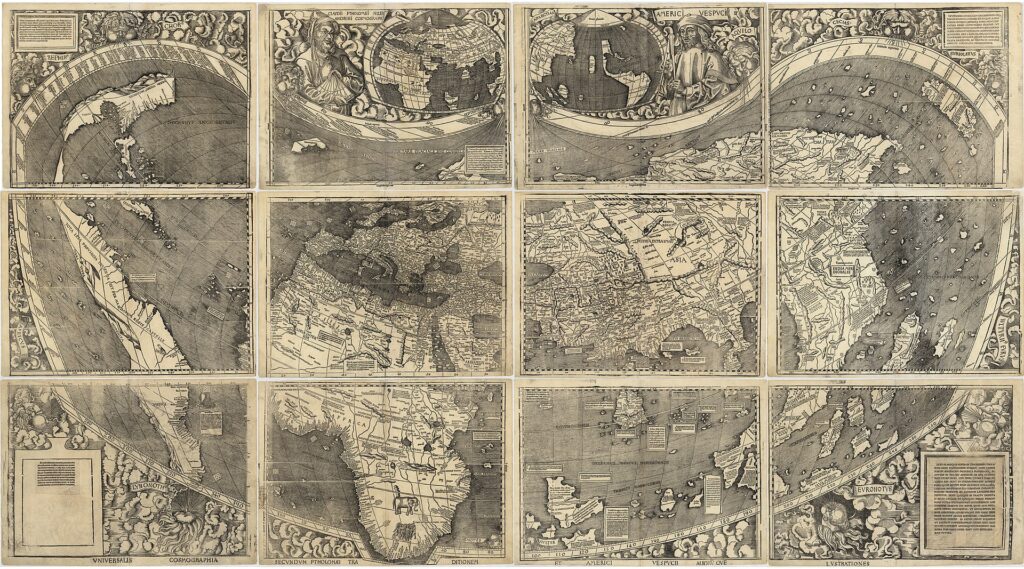On April 25, 1507, a world map emerged that would change the way we perceive the globe forever. Martin Waldseemüller, a German cartographer, created a planisphere that not only showcased the New World’s existence but also christened it with a new name: America. This seemingly small act had immense implications, as it solidified the idea of a separate continent, distinct from the known lands of Europe, Asia, and Africa. Let’s delve into the history and significance of this groundbreaking map, and how it shaped our understanding of the world.
Table of Content
ToggleThe Cartographer: Martin Waldseemüller
Martin Waldseemüller was born in Radolfzell, Germany, around 1470. He was a scholar, theologian, and cartographer, whose interest in geography led him to join the esteemed group of scholars at the Gymnasium Vosagense in Saint-Dié-des-Vosges, France. It was here that Waldseemüller created his famous 1507 map, which was accompanied by a book called “Cosmographiae Introductio” that described the methodology and sources used in its creation.
Amerigo Vespucci: The Inspiration for “America”
The name “America” is derived from Amerigo Vespucci, an Italian explorer and cartographer who challenged the prevailing notion that the lands discovered by Christopher Columbus were part of Asia. Vespucci’s letters and maps argued that the lands were part of a distinct, previously unknown continent. Waldseemüller, inspired by Vespucci’s findings, decided to honor him by naming the newfound continent “America” on his 1507 planisphere.
The 1507 Planisphere: A New Perspective on the World
Waldseemüller’s map was a large wall map, measuring approximately 4.5 by 8 feet. It was composed of twelve woodcut panels, which when assembled, presented a remarkably accurate depiction of the known world for its time. The map included the three known continents—Europe, Asia, and Africa—along with the newly-discovered lands of the Western Hemisphere, which Waldseemüller labeled as “America.”
The map’s significance cannot be overstated. It was the first map to recognize the Pacific Ocean, the first to depict a separate South American continent and the first to use the term “America” for the newly-discovered lands. The planisphere was widely circulated, with over 1,000 copies printed, and it greatly influenced subsequent cartography.
Legacy and Controversy
While Waldseemüller’s map was groundbreaking, it was not without controversy. Some historians argue that the name “America” should have been reserved for the entire Western Hemisphere, rather than being applied solely to the southern continent. In later editions of his maps, Waldseemüller himself seemed to regret his decision, removing the name “America” and replacing it with “Terra Incognita.”
Despite these controversies, the name “America” endured and became widely accepted. Today, Waldseemüller’s 1507 planisphere is considered one of the most important maps in the history of cartography, and a surviving copy is housed at the Library of Congress, serving as a testament to the power of exploration, discovery, and the impact of a single map on the way we perceive our world.
In the same year Congo Fell Prey to Portuguese Slave Traders
The history of the Congo region, located in Central Africa, is one of rich cultural heritage and untamed natural beauty. However, beneath the surface lies a dark and tragic past that reveals the horrors of exploitation and human suffering. In the early 16th century, the Kingdom of Kongo, a powerful African kingdom, fell victim to the Portuguese slave traders who were on a quest for ivory, copper, and slaves. This blog post explores the historical background of this pivotal moment in Congo’s history and the devastating effects it had on its people and culture.
The Kingdom of Congo: A Brief Background
Before the arrival of the Portuguese, the Kingdom of Congo was a flourishing and influential African kingdom. Established around the late 14th century, it was a centralized and hierarchical state, spanning modern-day Angola, the Democratic Republic of the Congo, the Republic of the Congo, and Gabon. The Congo people thrived on agriculture, fishing, and trade, and they were skilled in the production of textiles, pottery, and metalwork.
The Portuguese Arrive in Search of Wealth
In 1483, Portuguese explorer Diogo Cão reached the mouth of the Congo River, marking the beginning of European contact with the region. The initial interactions between the Kingdom of Kongo and Portugal were relatively amicable, with the two kingdoms forming a diplomatic and trade relationship. King Nzinga a Nkuwu, the ruler of the Kongo at the time, even converted to Christianity and adopted the name João I.
However, the Portuguese quickly became interested in exploiting the region’s resources. By 1507, the demand for ivory, copper, and slaves had intensified, and the Portuguese were eager to capitalize on this lucrative trade. The Kingdom of Kongo, unable to resist the military and technological superiority of the Portuguese, found itself drawn into a web of exploitation.
Congo’s Descent into the Slave Trade
Initially, the Kingdom of Kongo supplied the Portuguese with slaves, captured from neighboring regions or as prisoners of war. This allowed the Kongo to maintain their sovereignty while providing the Portuguese with the human capital they sought. However, as the demand for slaves grew, the Portuguese became increasingly aggressive, raiding and pillaging Kongo villages to acquire slaves for the transatlantic trade.
The relentless pursuit of slaves by the Portuguese had devastating effects on the Kongo society. The population dwindled as families were torn apart and communities destroyed. The once-thriving kingdom was destabilized and weakened, and the social fabric that held the Kongo people together began to unravel.
The Impact of the Portuguese Slave Trade on the Congo Region
The slave trade had far-reaching consequences for the Congo region, both in the short and long term. The immediate impact included the loss of millions of lives and the destruction of communities. The long-term effects were no less devastating. The decimation of the population, the collapse of the Kongo Kingdom, and the socio-economic disruption caused by the slave trade laid the groundwork for ongoing instability and conflict in the region.
Conclusion
Martin Waldseemüller’s 1507 planisphere marks a pivotal moment in the history of cartography and the world at large. By recognizing the distinct nature of the New World and giving it the name “America,” Waldseemüller forever altered our perception of the planet and its geography. His map serves as a reminder of the importance of exploration, innovation, and the role of cartographers in shaping our understanding of the world. As we continue to chart new territories and push the boundaries of our knowledge, let us remember the groundbreaking achievements of visionaries like Waldseemüller and their enduring contributions to the rich tapestry of human discovery.
The tragic story of the Congo falling victim to the Portuguese slave traders in 1507 is an essential reminder of the resilience and strength of the Congolese people who have endured centuries of exploitation, violence, and suffering. The dark history of the slave trade in Congo serves as a stark warning of the dangers of unchecked greed and the consequences of humanity’s darkest instincts.












